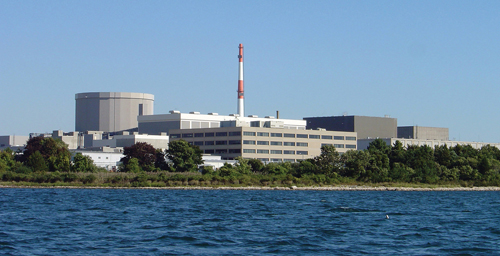County legislature approves $80K study of Millstone’s impact on Sound

In a split vote Tuesday, county lawmakers approved an $80,000 study on the impacts that Connecticut’s Millstone Nuclear Power Plant has on water temperature of the Long Island Sound.
The study comes in the wake of concerns over rising water temperatures in the Long Island Sound that researchers say are linked to significant population reductions in the Sound, especially in cold water species such as lobster and winter flounder, as well as eelgrass.
“This research is absolutely critical,” said Legis. Jay Schneiderman (I-Montauk), who sponsored the legislation calling for the study. “The Long Island Sound is warming at an alarming rate and everything I have been looking at points to the heat source being in that Waterford area.”
Stony Brook University’s School of Marine and Atmospheric Sciences, which will be conducting the study, requested county funding for the initiative, reporting that the Sound’s average water temperature that has increased by about 1 degree Fahrenheit per decade over the past 40 years. This, according to Dr. Chris Gobler — who will be leading the study — compares to an increase of about 1.8 degrees Fahrenheit worldwide over the last 80 years.
Each day, roughly two billion gallons of water is pumped from Long Island Sound into the Millstone Power Station to help cool systems and support the station’s two operating reactors. After it heats up, about 90 percent of that water is discharged back into the Sound at about 20 degrees warmer than when it was taken in, said Ken Holt, a spokesman for Millstone.
That processes releases approximately 15 million BTU’s of heat each hour into the Long Island Sound and is considered significant contributor to the warming of the water, said Mr. Schneiderman.
In September of 2013, Emerson Hasbrouck, a senior marine environmental issues educator at Cornell Cooperative Extension of Suffolk County, told The Suffolk Times that a combination of increasing water temperatures, low dissolved oxygen, pesticide run-off and nitrogen loading proved too much for the Sound’s lobster population, causing the extreme die-off in 1999.
However, not all county lawmakers are not convinced that a study would help fix the ecology issues facing the Sound. Notably, North Fork legislator Al Krupski (D-Cutchogue) cast one of five dissenting votes in the 11-5 tally. Mr. Krupski said the funding source for the study, a quarter-percent tax devoted to improving water quality, has limited resources, and those dollars would better suited to pay for proven water quality projects, not studies.
“There is very little money left for actual water quality improvement,” Mr. Krupski said. “Should we spend $80,000 on a study, or, should we spend the $80,000 on drainage, which we already know would improve water quality?”
Mr. Schneiderman countered by stating that the money put toward the study will not prevent the funding of water quality projects.
Though the two East End legislators are split on the study, they agree Millstone — located just under 10 miles from Plum Island — needs to be addressed.
“I mean, we would all like to close Millstone down,” Mr. Krupski said.
Mr. Schneiderman said the study’s findings could impact an upcoming decision that would allow the plant to continue to operate.
The federal Clean Water Act requires such plants to use the best available technology in order to best protect local environments, something Mr. Schneiderman says Millstone is not doing. Newer technologies, which release heat into the atmosphere instead of into nearby waters, have become the new environmental standard, he said.
To continue using its outdated systems, Millstone’s parent company, Virginia-based operator Dominion Power, will need a variance that expires in September.
Mr. Holt, previously told the Suffolk Times the company needs the variance since upgrading to the best available technology would not be financially feasible at this time. He estimated that the upgrades would run into the “billions of dollars,” and in an interview this week, said that the plant’s impacts on the Sound are questionable in the first place.
“We don’t feel that Millstone has a significant impact on the Long Island Sound as a whole,” Mr. Holt said.
Suffolk County Executive Steve Bellone, whose signature is needed following the vote, is expected to approve the study according to a spokesperson.
Mr. Gobler said the study should be complete by September.
With Joseph Pinciaro







